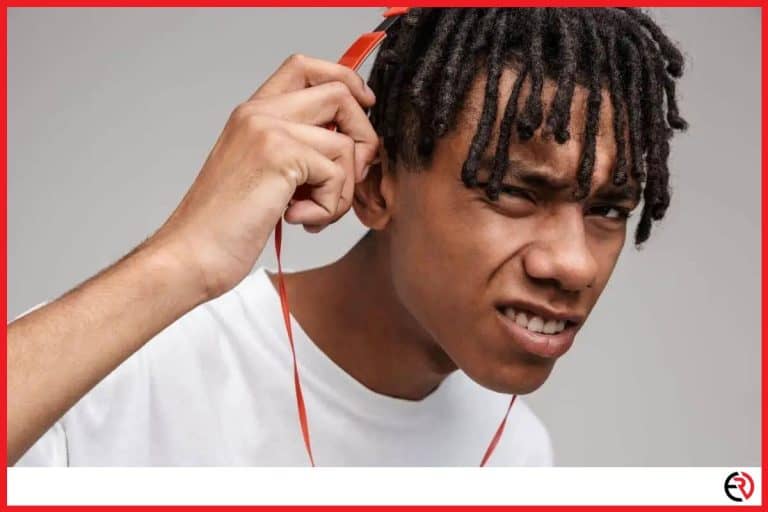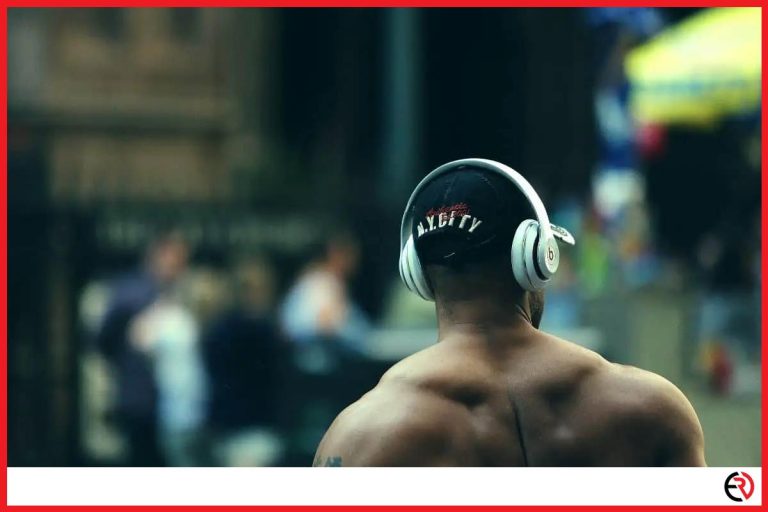Should You Wear Headphones While Biking?
This post may contain affiliate links which means that, if you choose to make a purchase, I may earn a small commission at no extra cost to you.
If you have ever driven a car while on your phone, you may have experienced a slight decrease in your ability to pay attention to the road. The science is simple. Your momentary perception can only handle so much information at any given time. Your eyes and brain can filter out unnecessary information, but the necessary information can still be too much. Being on a slower bike doesn’t change the equation. It just changes the physics. To find out more about the dangers and potential solutions check out the information below.
Wearing on-ear, over-ear, and earbuds while biking is dangerous. They can decrease the rider’s auditory perception. This means that a cyclist can’t hear other riders, pedestrians, or cars as well as they could. Because headphones block this safety factor, headphones should be switched out for devices that don’t block a cyclist’s ears.
Because there are other methods for listening to music and talking over the phone besides ear blocking headphones, it is still possible to have an audio device while cycling. These devices don’t require direct contact with your ears and therefor don’t block your normal listening skills. You always want to make sure that your audio device is allowed under your local laws. Check out the details below for a selection of laws and potential solutions.
Why is it Dangerous to Use Headphones While Riding a Bike?
It is inherently safer to bike or walk where there are more bikers and walkers. This makes sense. Cars are less likely to strike a pedestrian or cyclist if they are warned of the dangers from not the one cyclist but the hordes of cyclists. Bikes and pedestrians are more likely to be clear of cars if they are surrounded by a bubble of similar buddies. That is not always the situation.
Let’s take it from the extremes. If you could hear everything around you, as a cyclist your audio perception could absolutely help you with surrounding dangers. At the other end of the spectrum are loud headphones. If you couldn’t hear anything around you, as a cyclist you would absolutely feel more in danger because you couldn’t hear car horns, bike bells, whistles, yelling or anything else.
Because the human ear while riding a bike is limited and doesn’t have surround sound capability, any decrease in safety is a legal issue. Many states have limited the use of headphones while driving in cars and while cycling. Make sure you drive and ride legally wherever you are.
Think about riding in the city. First, if you are in an inner-city environment, you might not even have access to a bike lane. So, where will you be cycling? Most likely you will either be in the car lane or occasionally on the sidewalk. What noises would you want to hear?
- All types of cars and trucks
- Construction Site Activity
- All types of pedestrians
- Opening doors of parked cars
- Cars parallel parking or exiting a parking spot
- Food trucks and other sidewalk sales
- Constant light and crosswalk changes
- Just about any other noise you can think of
What about riding in the suburbs or the country? You might think that cycling down open roads would be significantly easier. However, that really isn’t the case. Why? Sure, there is less congestion, fewer pedestrians, and not as much construction. It is that lack of “stuff” that makes backroads cycling just as dangerous.
In the city you are likely going to have a low-speed accident with a car going upwards of 20 m/h. In the country, you are going to get hit by a semi-truck doing 80 m/h. The difference is both staggering and significant. There is no room for error outside of the city. With no shoulders or sidewalks, the only place to ride outside the city is in the fast car lane. Dangerous with headphones?
Yes.
Is it Legal in the US to Wear Headphones While Riding a Bike?
US States have taken note of the dangers of cycling with headphones. Most regulations began as a ban on driving with headphones. You can wear a single in-ear earbud, but you can’t have both ears covered. The same laws spread to cyclists and other modes of transportation due to the increased risk of distracted drivers and riders.
Here is a breakdown of the laws of 18 of the 50 States in the US with limitations on cyclists and headphones. As these laws are constantly changing, you will want to review the current laws at the time of your event and not rely on this list as up to date.
| STATEREGULATIONAlaska“Headphones and earbuds are not permitted, except when used for navigational purposes.”Arizona“It’s legal, though not for school bus drivers or anyone transporting children for a daycare facility.”California“Headphones and earbuds illegal, and that includes bicycles too.”Colorado“Headphones or earbuds covering both ears is prohibited, except for audio systems built into motorcycle helmets. Earpieces in one ear are permitted, for example for speaking on a phone.” | |
| Florida | “Headphones or earbuds prohibited while driving.” |
| Georgia | “Anything that diminishes hearing or sight while driving is prohibited. Though earpieces used for communication purposes are permitted.” |
| Illinois | “Headphones or earbuds covering both ears are not permitted. The exceptions are motorcycle helmet audio systems, and one-ear headsets and earpieces.” |
| Louisiana | “Headphones or earbuds prohibited while driving. Headphones built into motorcycle helmets exempt.” |
| Maryland | “Headphones or earbuds prohibited while driving.” |
| Massachusetts | “Headphones or earbuds prohibited while driving, unless they are involved in the control of the vehicle itself.” |
| Minnesota | “Headphones or earbuds prohibited while driving.” |
| New York | “Headphones or earbuds prohibited while driving.” |
| Ohio | “Headphones or earbuds prohibited while driving. Headphones built into motorcycle helmets exempt, as are hearing aids.” |
| Oregon | “It’s legal, but there are some regional exceptions.” |
| Pennsylvania | “Headphones or earbuds prohibited while driving. Single-ear audio systems for cellular communication OK, as are hearing aids.” |
| Rhode Island | “Headphones or earbuds prohibited while driving or operating a bicycle.” |
| Virginia | “Headphones or earbuds prohibited while driving. Headphones built into motorcycle helmets exempt, as are hearing aids.” |
| Washington | “Headphones or earbuds prohibited while driving. Hands-free wireless communication systems and motorcycle helmet audio systems are OK.” |
Note that all jurisdictions allow for hearing aid use and protective hearing in construction areas. However, it’s also important to note that the limitations aren’t on all types of audio devices, just the ones that cause the audio distraction by blocking the ears. If you have an audio device that delivers sound in another way, most jurisdictions, including the ones above don’t restrict them.
Are There Differences in the Type of Riding or the Sport?

Most of these examples are for roads, sidewalks, and other policed areas. What about other types of biking?
Most competitive sports that use bikes outlaw any musical devices while riding bikes. Sports like triathlons have had this rule in place for a long time. So, most pro athletes will happily jam out while indoor training, but when they hit the pavement, the headphones come off.
There are two reasons for this. First, the common safety issue is more important for these athletes as this is their paid job. Second, they need to train under similar conditions that will be in their races, which means no music on the course no music on the training circuit.
If you are literally taking your bike to a hiking trail or course, the management group may still have limitations on headphone use while biking to protect the other visitors. It is generally most safe to respect the fact that as a biker or cyclist, you will want to avoid hurting yourself or someone else.
How to Solve the Auditory Distracted Cyclist Problem
Don’t think that Bluetooth earbuds with “ambient awareness” will change the situation. So, if you see biking magazines recommend headphones, these listings are for general workouts and not for biking. Instead, you need specific biking advice and recommendations made uniquely for the attention and legal problems.
Here are some basic tips for your next ride.
- Leave One Ear Open
- Don’t Ever Use Noise Canceling Headphones
- Keep the Volume Low
- Always Stay Vigilant
- Follow the Local Laws
- Pull Over to Adjust the Volume
- Invest in a Bluetooth Helmet: Check out these Bluetooth Coros, Alta, or Lexin types
- Invest in a Clip-On Bluetooth Speaker: Check out these Bluetooth JBL and Zulu types
- Invest in Bone Conduction Headphones: Check out these Bluetooth Eken, AfterShokz, and Vidonn types
Focus on Staying Safe and Enjoying the World Around You
It’s true that cycling while listening to your best jams can increase your endurance by upwards of 15%, but maybe leave the headphones for the stationary bike. When you are riding down the road with the wind against your cheeks, you want to make sure that you finish the ride.
Music is always a welcome addition, but you don’t want it to ruin the experience with a crash. With the new tech audio toys coming out there are plenty of opportunities to pair your ride with hot jams.









